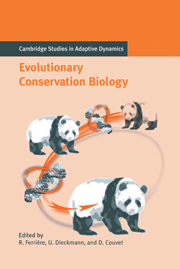Book contents
- Frontmatter
- Contents
- Contributing Authors
- Acknowledgments
- Notational Standards
- 1 Introduction
- Part A Theory of Extinction
- Part B The Pace of Adaptive Responses to Environmental Change
- Part C Genetic and Ecological Bases of Adaptive Responses
- Part D Spatial Structure
- 12 Genetic Structure in Heterogeneous Environments
- 13 Conservation Implications of Niche Conservatism and Evolution in Heterogeneous Environments
- 14 Adaptive Responses to Landscape Disturbances: Theory
- 15 Adaptive Responses to Landscape Disturbances: Empirical Evidence
- Part E Community Structure
- References
- Index
- The International Institute for Applied Systems Analysis
14 - Adaptive Responses to Landscape Disturbances: Theory
Published online by Cambridge University Press: 15 August 2009
- Frontmatter
- Contents
- Contributing Authors
- Acknowledgments
- Notational Standards
- 1 Introduction
- Part A Theory of Extinction
- Part B The Pace of Adaptive Responses to Environmental Change
- Part C Genetic and Ecological Bases of Adaptive Responses
- Part D Spatial Structure
- 12 Genetic Structure in Heterogeneous Environments
- 13 Conservation Implications of Niche Conservatism and Evolution in Heterogeneous Environments
- 14 Adaptive Responses to Landscape Disturbances: Theory
- 15 Adaptive Responses to Landscape Disturbances: Empirical Evidence
- Part E Community Structure
- References
- Index
- The International Institute for Applied Systems Analysis
Summary
Introduction
Habitat loss is probably the most important factor to cause species decline world-wide (Sih et al. 2000), but habitat fragmentation and deterioration are widespread also. The habitats of most species are no longer large homogeneous areas, but instead consist of small patches of habitable environment, often connected by migration paths. Some of these patches are inhabited, while others are empty. Inhabited patches may become empty because of demographic or environmental stochasticity, and empty patches may be colonized by dispersers. The collection of local populations forms a metapopulation, a concept originally introduced by Richard Levins (1969, 1970; see also Hanski and Gilpin 1997; Hanski 1999; and Chapter 4).
Dispersal is a key life-history trait in metapopulations, and the evolution of dispersal rates has attracted particular attention, both in the past (Roff 1974; Hamilton and May 1977; Comins et al. 1980; Motro 1982a; Motro 1982b; Hastings 1983; Levin et al. 1984; Frank 1986; Pease et al. 1989; Cohen and Levin 1991) and more recently (Olivieri et al. 1995; Cadet 1998; Gandon 1999; Gandon and Michalakis 1999; Parvinen 1999; Travis and Dytham 1999; Travis et al. 1999; Ronce et al. 2000a; Gyllenberg and Metz 2001; Heino and Hanski 2001; Metz and Gyllenberg 2001; Parvinen 2001b; Kisdi 2002; Nagy, in press). Changes in dispersal strategies provide an option for threatened populations to respond to the fragmentation of their habitats. Consequently, success or failure of such adaptation often determines whether a challenged population can persist.
- Type
- Chapter
- Information
- Evolutionary Conservation Biology , pp. 265 - 283Publisher: Cambridge University PressPrint publication year: 2004
- 8
- Cited by



